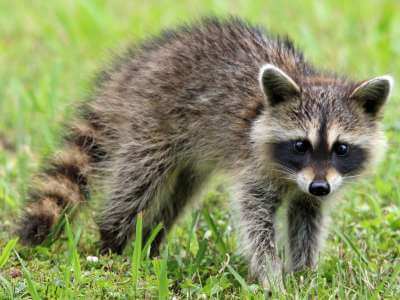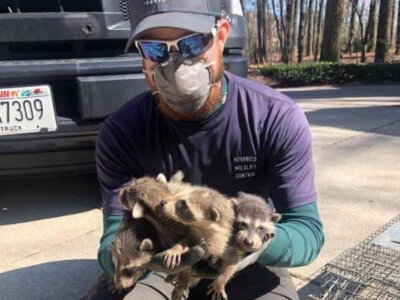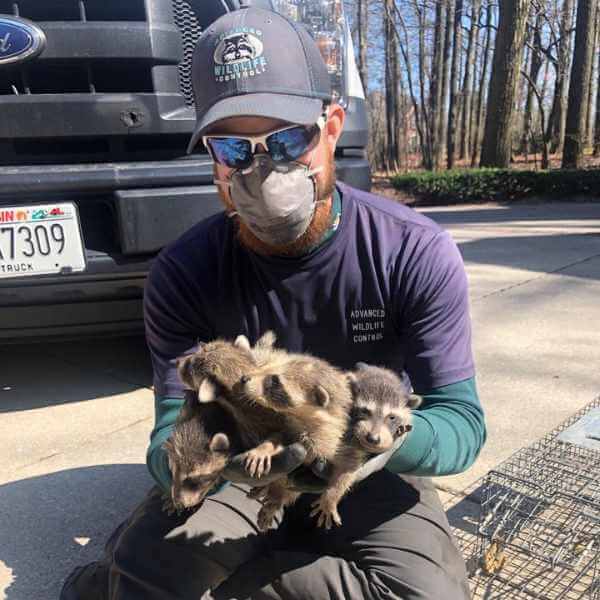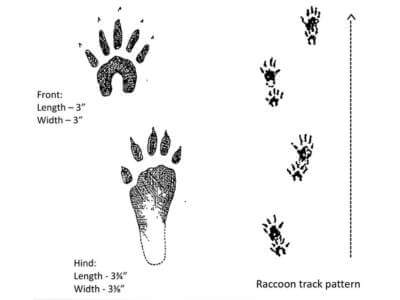
What Does a Raccoon Look Like?
Raccoons are easily identified by their mask-like band of black fur under their eyes and bushy, ringed tails. They usually have grayish-brown fur and are about 2 to 3 feet long. Adult raccoons can weigh between 10 and 20 pounds. These mammals have stout bodies, round ears, narrow snouts, short legs, and flat feet. Due to their longer hind legs, raccoons often appear hunched over when they walk or run.
What are the Signs of a Raccoon in Your Attic?
Female raccoons often seek shelter in attics, chimneys, and garages during the spring to raise their young. These clever creatures are excellent climbers and are skilled at finding access points to homes, including overhanging tree limbs and downspouts. Their strong, dexterous front paws allow them to easily tear through soffits or vents to enter a house. The most common sign of a raccoon infestation is the noise they make, particularly at night, as they scurry about in the attic or chimney.

Professional Raccoon Removal in Milwaukee, WI
Advanced Wildlife and Pest Control provides raccoon removal and exclusion services in Milwaukee and southeastern Wisconsin. Our certified wildlife specialists safely and efficiently trap, remove, and exclude nuisance raccoons from your home or business.
We will perform a thorough home inspection to identify signs of raccoon activity, such as droppings, nesting materials, tracks, and entry points. After the inspection, we will safely trap and remove the raccoon and seal all entry points to prevent future intrusions. Raccoon trapping is the most effective and humane way to remove a raccoon.

Raccoon Damage
Raccoons can cause serious damage to your attic, roof, and yard, resulting in costly repairs for homeowners. These intelligent pests are constantly on the hunt for both food and shelter. Their strong and agile paws allow them to tear off shingles, fascia boards, and soffits to gain access to attics. Once inside, raccoons rip apart insulation to make nests and contaminate it with urine and feces. Additionally, raccoons may dig up lawns while searching for grubs and eat garden vegetables.
Raccoon Diseases
Raccoons can carry diseases and parasites, including rabies, leptospirosis, distemper, fleas, and roundworms. If you are bitten or scratched by a raccoon, you should wash the wound with soap and water and see a doctor as soon as possible. It’s important to avoid contact with raccoons as they can become aggressive when cornered or protecting their young. Even if a raccoon appears calm or friendly, you should never approach a wild animal.
Raccoon Exclusion
Raccoons are a common nuisance for homeowners. These critters often enter yards in search of food, water, and shelter in attics and chimneys. The most effective way to prevent raccoons is to create exclusions and habitat modifications around your home. Our wildlife specialists can identify and seal potential entry points to secure your home and prevent future wildlife problems.
- Secure trash cans.
- Don’t leave pet food outside.
- Install chimney caps and vent covers.
- Trim tree branches that overhang the roof.
Raccoon FAQs
Frequently Asked Questions
What do raccoons eat?
Raccoons are omnivores with an opportunistic diet, eating almost anything they can get their paws on. Raccoons feed on insects, crayfish, fish, small rodents, birds, eggs, nuts, seeds, fruits, and berries. In urban areas, raccoons will eat human food and invade trash cans.
Where do raccoons live?
Raccoons are found throughout Wisconsin. They prefer heavily wooded areas with access to trees, water, and abundant vegetation. Raccoons make their dens in hollow parts of trees, brush piles, and abandoned burrows. They are highly adaptable and can also be found in suburban and urban areas, making their homes in man-made structures like attics, chimneys, barns, sheds, sewers, and underneath decks.
When do raccoons have babies?
Male raccoons are polygamous and will mate with several females, while females are monogamous and will usually mate with only one male. The mating season runs from January through March, and gestation lasts approximately two months. The female will raise one litter of three to four young each year. Kits are weaned between two and three months of age. However, young raccoons typically remain with their mother throughout the fall and winter before venturing off on their own.
How long do raccoons live?
The average lifespan of a raccoon in the wild is two to five years. They can live significantly longer in captivity, generally eight to ten years. Raccoons have a few predators, including coyotes, bobcats, foxes, cougars, and domestic dogs. Unfortunately, many raccoons are killed by automobiles or disease.
What sounds do raccoons make?
Homeowners will mostly hear raccoon noises at night. Raccoons are very loud and vocal animals, making sounds like whistling, hissing, snarling, or growling. Baby raccoons are especially noisy and their chirping and whimpering sounds are often mistaken for birds.
What does raccoons poop look like?
Raccoon scat is tubular with blunt ends and approximately 3 to 5 inches long. The color and consistency may vary due to the raccoon's diverse diet. Droppings of many similar-sized mammals are pointed or rounded. Raccoons create latrine sites around trees, logs, rooftops, and attics.
What do raccoon tracks look like?
Raccoons are excellent climbers with strong, dexterous front paws that can pry off shingles, fascia boards, and roof vents to access attics and chimneys. Raccoon tracks resemble a baby's handprint with five toes on each foot. Both front and hind paw prints are similar, but the hind tracks have an elongated heel that sinks deeper into the ground. Raccoons have claws on all of their toes and walk flat-footed. The front and opposite hind tracks will be side by side or close together.

Illustration by Dan Goodman
